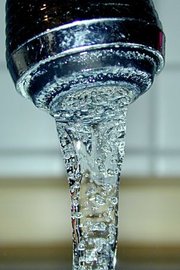Dihydrogen monoxide hoax
|
|
Dihydrogen monoxide (DHMO) is a scientific-sounding name for water used in a common hoax that illustrates how ignorance of science can lead to misplaced fears among environmental activists and others.
The joke involves attributing common attributes and uses of water to "dihydrogen monoxide", then asking people to take action to control this dangerous-seeming chemical.
Although this hoax was brought to widespread public attention in 1997, when Nathan Zohner, a 14-year-old student, gathered petitions to ban "DHMO" as the basis of his science project, aptly titled "How Gullible Are We?", the hoax actually predates Zohner by many years (see, for instance, this Usenet posting from 1990 (http://groups-beta.google.com/group/rec.humor.funny/browse_thread/thread/3f985a069a2a19d8/))
| Contents |
DHMO
The joke usually follows roughly this format:
The uses of dihydrogen monoxide are varied and growing:
- As an industrial solvent and coolant;
- In nuclear power plants;
- In the production of styrofoam;
- As a fire retardant;
- In many forms of cruel animal research;
- In the distribution of pesticides;
- As an additive in certain "junk-foods" and other food products;
The list of risks associated with dihydrogen monoxide include:
- The substance is a major component of acid rain;
- Contributes to soil erosion;
- Accelerates corrosion and breakdown of metals and electrical equipment;
- Excessive ingestion may cause various unpleasant, though generally not life-threatening, effects;
- Prolonged contact with its solid form results in severe tissue damage;
- May cause electrical failures and decreased effectiveness of automobile brakes;
- Inhalation, even in small quantities, may cause death;
- Its gaseous form may cause severe burns;
- It has been found in the tumors of terminal cancer patients;
- Withdrawal by those addicted to the substance causes certain death within 168 hours;
- Large quantities of the substance are dumped into rivers and streams by factories;
Nevertheless, the government and corporations continue using it widely, heedless of its grave dangers.
Terminology
The water molecule has the chemical formula H2O, meaning that one molecule of water is composed of two hydrogen atoms and one oxygen atom.
The prefix "di" means two and "mon" is short for "mono" meaning one. Oxide is often used to refer to oxygen. Literally, the term dihydrogen monoxide is "Two hydrogen, One oxygen", refering to the chemical formula.
Water is, however, a combination of H+, OH- (hydroxide), H20, and H30+ (hydronium); not even counting the inevitable dissolved gases. The hydrogen atom is constantly changing its bonds. This makes water both an acid and a base and thus an excellent solvent.
Water has a regular scientific or systematic name (hydrogen oxide) as well as an alkali name (hydrogen hydroxide) and two acid names (hydroxic acid or hydroxilic acid).
Public efforts 'against' DHMO
DHMO—along with similar "chemicals"—has been used for a number of public hoaxes, including:
- In 1997, Nathan Zohner—a 14-year-old, junior high student at Idaho Falls, Idaho—gathered 43 votes to ban the chemical, out of 50 people surveyed among his classmates. Zohner received the first prize at Greater Idaho Falls Science Fair for analysis of the results of his survey.
- Kate Dalgleish and Mikael Sydor—high school students from Calgary, Canada—circulated a petition to ban the chemical as part of the Western Canada High School film festival. Several high school chemistry teachers and university science students signed the petition, which asked the municipal government to ban the 'dangerous chemical' under a fictitious Hazardous Chemical Act. Their film won the film festival and was circulated through several local high schools.
- The idea was also used for an episode of the Penn & Teller show Bullshit!, in which they had self-proclaimed environmentalists sign a petition to ban DHMO.
- A similar hoax was perpetrated in Britain around the idea of an addictive, fattening substance known as 'CAKE', as part of the spoof news show Brass Eye. Some politicians were persuaded to speak out against this menace to society.
- Some University of California, Santa Cruz students wrote up and distributed fliers about DHMO and fooled a number of people. Soon after, they put the joke on the Internet, which had just been developed. This was apparently the first time that the DHMO joke went online and drew widespread attention.
Real public action
- In March 2004, Aliso Viejo, California almost considered banning the use of foam containers at city-sponsored events because dihydrogen monoxide is part of their production. The issue was put on the agenda of the City Council after a paralegal found mention of DHMO online and did not realize it was a joke. The item was pulled from the agenda before it could come to a vote, but not before the city received plenty of bad publicity.
External links
- Dihydrogen Monoxide Research Division (http://www.dhmo.org)
- Snopes' DHMO report (http://www.snopes.com/toxins/dhmo.htm)
- Safety Warning: Dihydrogen Monoxide (http://urbanlegends.about.com/library/bl_ban_dhmo.htm)
- Coalition in support of hydrogen hydroxide (http://www.armory.com/~crisper/DHMO/)
- How gullible are we when it comes to science? (http://www.stats.org/record.jsp?type=news&ID=33)
- Kate Dalgleish and Mikael Sydor's DHMO movie (http://www.dhmo.tk)
- Aliso Viejo DHMO incident (http://www.msnbc.msn.com/id/4534017/)
- Some responses to the DHMO joke by college educated students (http://www.lhup.edu/~dsimanek/dhmofoot.htm)ja:DHMO

